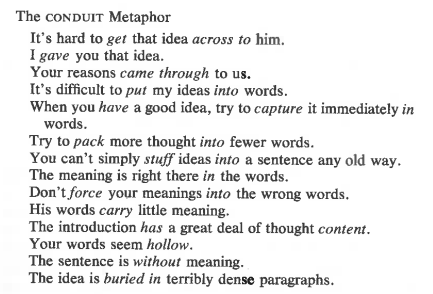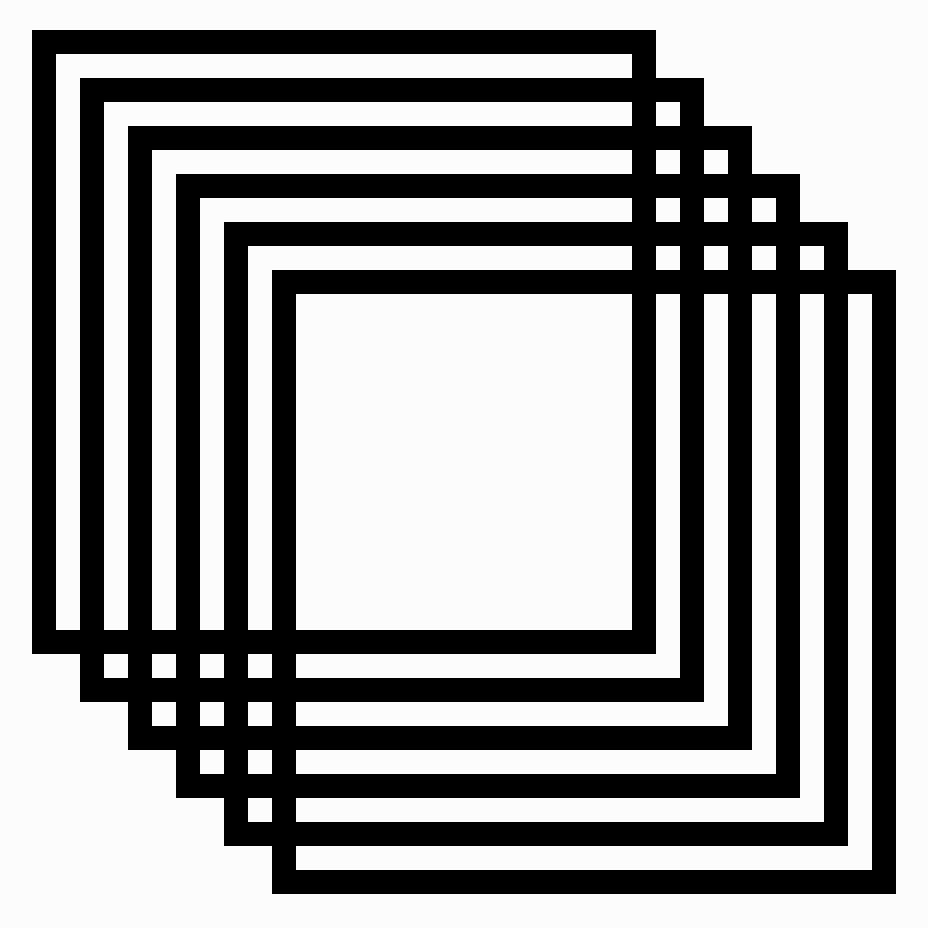Ideas are not objects
by Cristóbal
The conduit metaphor for communication is one of the many examples set out in Lakoff and Johnson’s Metaphors We Live By.
- Ideas (or meanings) are objects,
- Linguistic expressions are containers, and
- Communication is sending.
The authors give ordinary language examples in which the metaphor’s structuring of our thoughts become explicit, making a compelling case for its dominance.

I want to critique this specific metaphor, as it is particularly insiduous among mathematically-inclined dilettantes in semiotics (one of which I should be considered). The conduit metaphor deceptively buttresses desires for shared knowledge graphs, the hope that precisely defined words with formally derived argumentation can resolve disagreements, the aesthetics of minimalist writing, and the impression of sentience in large language models.
At its core, it imagines language as a puzzle, with precisely defined rules and operations through which one can find the answer. A sequence of words becomes an analytic unit which can then be formally manipulated akin to algebra. The meaning, contained in these units, is transformed by these operations precisely. Communication, then, is just means of giving another person the correct sequence of transformations. In reality, language turns out to be a riddle that, only with the appropriate experience, snaps into clarity and becomes self-evident.
In Penser/Classer, Georges Perec introduces a game his OuLiPo companion, Marcel Benabou, would play. Through it we’ll notice just how much the conduit leaves out. First, we define a series of grammars, e.g. A is the continuation of B by other means. A little A carries us away from B, a lot brings us closer. Happiness is in A, not B. A is a malady for which B is the cure. &c. These clichés are then filled in with a vocabulary, e.g. “remebering” and “forgetting.”
- Remebering is a malady for which forgetting is the cure.
- Remebering wouldn’t be remembering if it weren’t for forgetting.
- What comes by remembering goes by forgetting.
- Small forgettings make big rememberings.
- Remebering adds to our pains, forgetting to our pleasures.
- Remembering delivers us from forgetting, but who will deliver us from remembering.
- Happiness is in forgetting, not in remembering.
- Happiness is in remembering, not in forgetting.
- A little forgetting carries us away from remembering, a lot brings us closer.
- Forgetting unites men, remembering divides them.
These generated aphorisms seem to hold some measure of truth, depsite being mere combinatorial artifact. A theory of meaning must account for this. Perec asks the critical question: where is the thinking? Is it in the formula, the vocabulary, or the algorithm?
I’d like to suggest, perhaps obviously, that the thinking occurs inside the reader. In other words, the meaning is not at all contained in the analytic framework provided, but rather in a kind of resonance between reader and syntagm. The conduit metaphor then fails primarily for assuming that communication is independent of the people on each side. The meaning is not in the container, and the words have no meaning on their own.

The Necker Cube, oscillating between stable points.
As an alternative metaphor, consider the Necker cube. It is a bi-stable drawing, perceptually obvious to the viewer until it flips into its other stable point. A slight bit of priming, in this case the hiding of lines through a faux-occlusion, can force the viewer into either position. With this image in mind, a bit simplistically, though in my eyes much more productively, I’d like to suggest:
- Linguistic expressions are Necker cubes,
- Ideas (or meanings) are stable points, and
- Communication is priming.
Note that we begin with the concrete artifact, the linguistic expression, as an inherently unstable foundation. In this framing, priming becomes a dance between the parties attempting to communicate, grasping at the nebulous Necker cube they are constructing and attempting to arrive, together, at the same stable point. Curiously, writing is a kind of self-reflexive Necker cube, where the means of priming are themselves unstable. Perhaps this begins to point to the complexity of fiction, but also its power. The aphorism is a place to begin this analysis.
Despite their triteness, aphorism can hold special places in our philosophical constellations, becoming north stars. However, very much because of their triteness, communicating why they are meaningful to yourself is often a helpless task. There is a whole experiential corpus, an internal narrative at work, which is priming that phrase into coherence. The thinking is in the reader and the meaning is just one of the possible stable points. Explaining this to other feels like a helpless task.
This perhaps points to a communicative function of art: the expression of just one of these stable points, independently of the baggage of the viewer. The process of art-making becomes the construction of an apparatus which somehow compresses what is needed to prime you to its intended meaning. This is power of the novel or film that just hits. It manages to show you, despite all your past experience, that the dress is not just black and blue, but also white and gold.